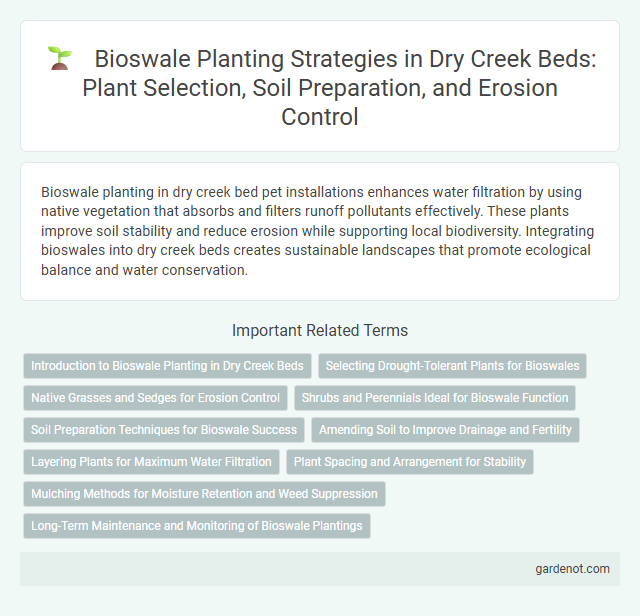Bioswale planting in dry creek bed pet installations enhances water filtration by using native vegetation that absorbs and filters runoff pollutants effectively. These plants improve soil stability and reduce erosion while supporting local biodiversity. Integrating bioswales into dry creek beds creates sustainable landscapes that promote ecological balance and water conservation.
Introduction to Bioswale Planting in Dry Creek Beds
Bioswale planting in dry creek beds utilizes native, drought-tolerant vegetation to enhance water infiltration and filter pollutants from stormwater runoff. These plants, including sedges, rushes, and deep-rooted grasses, stabilize soil and reduce erosion while supporting habitat biodiversity. Incorporating bioswales transforms dry creek beds into functional landscapes that improve water quality and manage urban runoff effectively.
Selecting Drought-Tolerant Plants for Bioswales
Selecting drought-tolerant plants for bioswales in dry creek beds enhances water conservation and soil stability while reducing irrigation needs. Native species like California fescue, purple coneflower, and yarrow thrive in arid conditions and support local ecosystems. Integrating deep-rooted shrubs and grasses maximizes infiltration and filtration, promoting effective stormwater management.
Native Grasses and Sedges for Erosion Control
Bioswale planting in dry creek beds utilizes native grasses and sedges to enhance erosion control by stabilizing soil with deep, fibrous root systems. Species such as Carex and Bouteloua improve water infiltration while reducing surface runoff, effectively minimizing sediment displacement. Incorporating these drought-tolerant plants supports sustainable stormwater management and promotes ecological resilience in riparian zones.
Shrubs and Perennials Ideal for Bioswale Function
Shrubs such as Red Twig Dogwood (Cornus sericea) and Inkberry Holly (Ilex glabra) are ideal for bioswale planting due to their deep root systems that enhance soil stability and water infiltration. Perennials like Switchgrass (Panicum virgatum) and Blue Flag Iris (Iris versicolor) provide efficient pollutant uptake and improve runoff filtration in dry creek beds. These species contribute to bioswale function by reducing erosion, promoting groundwater recharge, and supporting urban stormwater management.
Soil Preparation Techniques for Bioswale Success
Effective soil preparation techniques for bioswale success in dry creek beds emphasize deep tilling to improve soil aeration and promote root growth. Incorporating organic matter such as compost enhances soil structure, water retention, and nutrient availability for bioswale plants. Ensuring proper grading and soil permeability supports optimal drainage and reduces erosion within the dry creek environment.
Amending Soil to Improve Drainage and Fertility
Amending soil in a dry creek bed bioswale enhances drainage and fertility by incorporating organic matter like compost and well-draining materials such as sand or perlite. This improves water infiltration and nutrient retention, supporting healthy plant growth and reducing erosion. Proper soil amendment fosters a sustainable environment for native plants and maximizes pollutant filtration in stormwater management.
Layering Plants for Maximum Water Filtration
Bioswale planting employs strategic layering of deep-rooted plants, native grasses, and dense ground covers to maximize water filtration efficiency in dry creek beds. Each plant layer contributes unique filtration capabilities, with deep roots breaking up soil and enhancing infiltration, while surface vegetation traps sediments and pollutants. This multi-tiered planting approach significantly improves runoff water quality by promoting natural filtration and reducing erosion.
Plant Spacing and Arrangement for Stability
Proper plant spacing and arrangement in bioswale planting within dry creek beds enhance soil stabilization and water absorption. Utilizing native deep-rooted species spaced 18 to 24 inches apart creates a dense vegetative mat that reduces erosion and supports stormwater filtration. Strategic grouping of plants with varied root depths maximizes structural integrity and ecological resilience in fluctuating moisture conditions.
Mulching Methods for Moisture Retention and Weed Suppression
Bioswale planting in dry creek beds benefits significantly from organic mulching methods such as wood chips or straw, which enhance moisture retention by reducing evaporation and maintaining soil temperature. Effective mulching also suppresses weed growth by blocking sunlight and creating a physical barrier, minimizing competition for nutrients and water. Proper mulch application, ideally 3-4 inches thick and kept away from plant stems, maximizes these benefits, promoting healthy plant establishment and improving bioswale performance in managing stormwater runoff.
Long-Term Maintenance and Monitoring of Bioswale Plantings
Long-term maintenance and monitoring of bioswale plantings in dry creek beds ensure effective stormwater management and pollutant filtration. Regular inspection of plant health, soil conditions, and erosion control prevents degradation and promotes sustained function. Adaptive maintenance strategies, including seasonal pruning and invasive species removal, support the resilience and biodiversity of the bioswale ecosystem.
Bioswale planting Infographic

 gardenot.com
gardenot.com